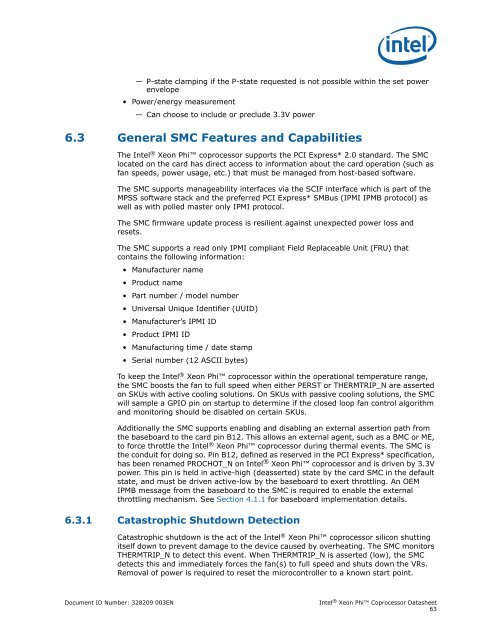Xeon-Phi-Coprocessor-Datasheet
Xeon-Phi-Coprocessor-Datasheet
Xeon-Phi-Coprocessor-Datasheet
Create successful ePaper yourself
Turn your PDF publications into a flip-book with our unique Google optimized e-Paper software.
— P-state clamping if the P-state requested is not possible within the set power<br />
envelope<br />
• Power/energy measurement<br />
— Can choose to include or preclude 3.3V power<br />
6.3 General SMC Features and Capabilities<br />
The Intel ® <strong>Xeon</strong> <strong>Phi</strong> coprocessor supports the PCI Express* 2.0 standard. The SMC<br />
located on the card has direct access to information about the card operation (such as<br />
fan speeds, power usage, etc.) that must be managed from host-based software.<br />
The SMC supports manageability interfaces via the SCIF interface which is part of the<br />
MPSS software stack and the preferred PCI Express* SMBus (IPMI IPMB protocol) as<br />
well as with polled master only IPMI protocol.<br />
The SMC firmware update process is resilient against unexpected power loss and<br />
resets.<br />
The SMC supports a read only IPMI compliant Field Replaceable Unit (FRU) that<br />
contains the following information:<br />
• Manufacturer name<br />
• Product name<br />
• Part number / model number<br />
• Universal Unique Identifier (UUID)<br />
• Manufacturer’s IPMI ID<br />
• Product IPMI ID<br />
• Manufacturing time / date stamp<br />
• Serial number (12 ASCII bytes)<br />
To keep the Intel ® <strong>Xeon</strong> <strong>Phi</strong> coprocessor within the operational temperature range,<br />
the SMC boosts the fan to full speed when either PERST or THERMTRIP_N are asserted<br />
on SKUs with active cooling solutions. On SKUs with passive cooling solutions, the SMC<br />
will sample a GPIO pin on startup to determine if the closed loop fan control algorithm<br />
and monitoring should be disabled on certain SKUs.<br />
Additionally the SMC supports enabling and disabling an external assertion path from<br />
the baseboard to the card pin B12. This allows an external agent, such as a BMC or ME,<br />
to force throttle the Intel ® <strong>Xeon</strong> <strong>Phi</strong> coprocessor during thermal events. The SMC is<br />
the conduit for doing so. Pin B12, defined as reserved in the PCI Express* specification,<br />
has been renamed PROCHOT_N on Intel ® <strong>Xeon</strong> <strong>Phi</strong> coprocessor and is driven by 3.3V<br />
power. This pin is held in active-high (deasserted) state by the card SMC in the default<br />
state, and must be driven active-low by the baseboard to exert throttling. An OEM<br />
IPMB message from the baseboard to the SMC is required to enable the external<br />
throttling mechanism. See Section 4.1.1 for baseboard implementation details.<br />
6.3.1 Catastrophic Shutdown Detection<br />
Catastrophic shutdown is the act of the Intel ® <strong>Xeon</strong> <strong>Phi</strong> coprocessor silicon shutting<br />
itself down to prevent damage to the device caused by overheating. The SMC monitors<br />
THERMTRIP_N to detect this event. When THERMTRIP_N is asserted (low), the SMC<br />
detects this and immediately forces the fan(s) to full speed and shuts down the VRs.<br />
Removal of power is required to reset the microcontroller to a known start point.<br />
Document ID Number: 328209 003EN<br />
Intel ® <strong>Xeon</strong> <strong>Phi</strong> <strong>Coprocessor</strong> <strong>Datasheet</strong><br />
63


